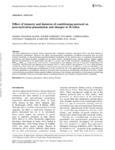Mostrar o rexistro simple do ítem
Effect of intensity and duration of conditioning protocol on post-activation potentiation and changes in H-reflex
| dc.contributor.author | Carballeira, Eduardo | |
| dc.contributor.author | Iglesias-Soler, Eliseo | |
| dc.contributor.author | Paredes, Xavier | |
| dc.contributor.author | Márquez, Gonzalo | |
| dc.contributor.author | Fernández-del-Olmo, Miguel | |
| dc.date.accessioned | 2024-04-05T12:36:21Z | |
| dc.date.available | 2024-04-05T12:36:21Z | |
| dc.date.issued | 2011-01 | |
| dc.identifier.citation | Eliseo IglesiasSoler, Xavier Paredes , Eduardo Carballeira , Gonzalo Márquez & Miguel Fernández-Del-Olmo (2011) Effect of intensity and duration of conditioning protocol on post-activation potentiation and changes in H-reflex, European Journal of Sport Science, 11:1, 33-38, DOI: 10.1080/17461391003770517 | es_ES |
| dc.identifier.issn | 1746-1391 | |
| dc.identifier.uri | http://hdl.handle.net/2183/36072 | |
| dc.description.abstract | [Abstract]: The force enhancement of muscle twitch contraction after a maximal voluntary contraction (MVC) has been defined as post-activation potentiation. However, the effects of post-activation potentiation on ballistic movements have not been studied extensively, or the underlying neurophysiologycal mechanism. In the current study, we examined post-activation potentiation and spinal H-reflex excitability in the soleus muscle. Mechanical power during explosive ballistic plantar flexions was measured in 14 males before and after 5 s, 4 min, and 10 min of isometric conditioning (EPFpre, EPF5s, EPF4min, EPF10min, respectively). Four sessions corresponding to four different protocols of isometric conditioning were conducted. The protocols were different in the intensity (10% vs. 100% of MVC) and duration (7 vs. 10 s) of the isometric conditioning. The results showed a significant enhancement in mechanical power in EPF4min compared with EPFpre, only when the isometric conditioning was performed at 100% of MVC for 10 s. No significant changes were observed in the H-related parameters (e.g amplitude, threshold, H/M ratio) after the isometric conditioning. Our results show that to obtain a post-activation potentiation during explosive ballistic movements, the intensity and duration of the isometric conditioning must be controlled. Moreover, the improvement in mechanical power is not related to spinal H-reflex excitability. | es_ES |
| dc.language.iso | eng | es_ES |
| dc.publisher | Routledge | es_ES |
| dc.relation.uri | http://dx.doi.org/10.1080/17461391003770517 | es_ES |
| dc.rights | Atribución-NoComercial-SinDerivadas 4.0 España | es_ES |
| dc.rights.uri | http://creativecommons.org/licenses/by-nc-nd/3.0/es/ | * |
| dc.subject | Post-activation potentiation | es_ES |
| dc.subject | Plantar flexion | es_ES |
| dc.subject | H-reflex | es_ES |
| dc.title | Effect of intensity and duration of conditioning protocol on post-activation potentiation and changes in H-reflex | es_ES |
| dc.type | journal article | es_ES |
| dc.rights.accessRights | open access | es_ES |
| UDC.journalTitle | European Journal of Sport Science | es_ES |
| UDC.volume | 11 | es_ES |
| UDC.issue | 1 | es_ES |
| UDC.startPage | 33 | es_ES |
| UDC.endPage | 38 | es_ES |
| dc.identifier.doi | http://dx.doi.org/10.1080/17461391003770517 | |
| UDC.coleccion | Investigación | es_ES |
| UDC.departamento | Educación Física e Deportiva | es_ES |
| UDC.grupoInv | Performance and Health Group (PH-G) | es_ES |
Ficheiros no ítem
Este ítem aparece na(s) seguinte(s) colección(s)
-
Investigación (CCDEF) [297]






